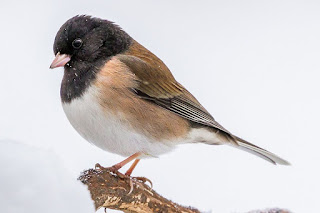It is that time of year! Noticeably, the days are beginning
to warm and the sun is casting its light a little longer with each day. If
you look and listen closely, you will notice pops of color from dormant flowers
beginning to bloom, the birds have started singing, spring is here!
Image 1. Ruby Crowned Kinglet. Photo by Paul Higgins.
After months of quiet skies, the Oregon juncos’ song will make
your heart skip a beat. Many of the birds in our forest do not migrate, but
their songs are silenced during the cold winter months. I like to believe they are saving up their
vocal chord strength for their spring song, when the males are in full singing
form to attract their mate! Since the Oregon junco does not leave our forest in
the winter, they are the first species to declare that spring is near. When the
days get longer, they know it is time to find a mate, so they open their throat and let their trilly-song come through, and each time I hear it, I cannot help
but smile.
Image 2. Oregon Junco. Photo by: Sandy Stewart.
The courtship behaviors that birds enlist to entice a mate come in a variety of forms, which allow other birds to make judgments on their
health and strength – how beautiful is their song? Are their feathers as
bright, if not brighter, then a bird of the same species? Will they provide
food for my offspring? Can they build a nest? Some species will even ask, how
well can this potential mate dance? –these questions are inherent in a bird’s
choice in a mate. They want to be sure they are choosing the best, so that
their offspring can survive their first year and continue to thrive throughout
its’ life.
Image 3. American Robin. Photo by: Doug Brown.
The world is filling up with bird songs. The American
robins’ rich, drawn out notes that one can recognize as a phonetic text of
“cheer-up, cheerily, cheer-up, cheerio” who I always hear as the first singer
in the morning and the last in the evening. The Ruby-crowned Kinglets
high-pitched “liberty-liberty-liberty” the mountain chickadees recognizable “cheeseburger”
or my favorite, who I heard calling from a distance and was able to spot on the
trail this past week, the Nashville warbler, whose yellow belly and blue-gray
cap one cannot miss. If you can find time to spend outdoors, turn your ears and
eyes to the sky, you will not be disappointed!
Image 4. Nashville Warbler. Photo by: Mike Danzenbaker.
Photo credit:
Ruby-crowned Kinglet photo: http://www.utahbirds.org/birdsofutah/BirdsL-R/RubyCrownedKinglet3.htm
Oregon Junco photo: http://www.thespruce.com/pictures-of-juncos-4121961American Robin Photo: https://identify.whatbird.com/obj/212/overview/American_Robin.aspx
Nashville Warbler Photo: http://avesphoto.com/website/na/species/WARNAS-1.htm




Comments
Post a Comment